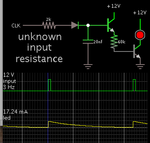Zak28
Advanced Member level 2
I have a circuit were a LED blinks for ~10mS every few seconds as its attached to the output of an oscillator which triggers a transistor to further operate the circuit and that LED is supposed to be an indicator for circuit operation. Is there a simple method to increase the LED firing duration? The 10mS duration is far too short. I would like something simple.
Thank you.
Thank you.


